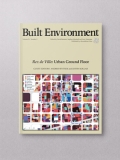High-Rise Urbanism in Contemporary Europe
About this issue
Issue number
Volume 43 – Number 4
Summary
This issue of Built Environment explores the processes of contemporary European urban verticalization and examines what these recent upward trajectories indicate about the social, political, economic and cultural dynamics of European urbanization.
Europe has witnessed during the twenty first century its greatest ever period of high-rise construction. From London to Rotterdam, Barcelona, Moscow, Madrid, Vienna, Milan, Turin, paris, Lyon and warsaw, European city skylines have become higher, denser and more diverse. after a fallow period during which very few towers were built (1980–2000), European cities are currently experi-encing a renewed interest in this architectural form, following in the footsteps of the United states and emerging economies. while the resurgence of skyscrapers in Europe has, to date, been somewhat modest in terms of height compared to the Middle East or south-east asia, it has reached unprecedented pro-portions in a significant number of European countries, exceeding the post-war boom period,prompting the need to assess the nature of this upward urban growth (figure 1).
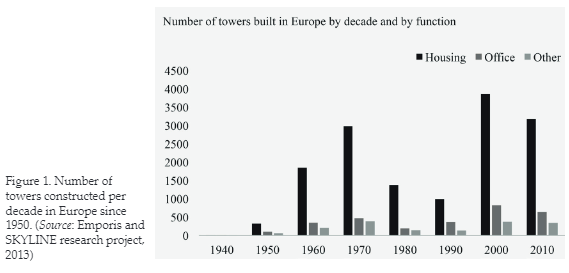
This issue of Built Environment explores the processes of contemporary European urban verticalization and examines what these re-cent upward trajectories indicate about the social, political, economic and cultural dy-namics of European urbanization. Through a combination of particular case-studies across Europe with wider analyses of national and international trends, the issue investigates the relationship in European cities between high-rise built fabric and planning regimes, finan-cial flows, cultural representations, technical innovations, and forms of modernist heritage. Developing cross-disciplinary perspectives and engagement with both academic and practitioner insights, the issue provides an initial assessment of high-rise Europe in the context of a wider world of vertical urbanisms (Graham and Hewitt, 2013; Harris, 2015).
European cities occupy a special place in the modern history of vertical urbanism. while European industrial architectural and engineering research inspired the construc-tion of the first skyscrapers in the United States (Cohen, 1995), North american vertical architecture became in turn a key reference for post-war European planners in modern-izing urban centres (destroyed by conflict and plagued by housing shortages) according to a modernist perspective largely inspired by the circulation of references from across the atlantic (Gartman, 2000). However, contrary to its North american model, European post-war vertical urbanism was characterized by a culture of large-scale urban planning which was mainly the product of highly centralized forms of state intervention, a configuration that helped create distinctive types of Europeanhigh-rise housing (figure 2). This includedthe role for new architectural and structural standards, technological innovations and a shared culture of urban engineering in de-fining a vertical urbanism that spread well beyond European national borders (Tailland-ier et al., 2009). For example, many French architects and engineers of the post-war ‘re-construction’ period started their career in co-lonial cities before coming back to the French urban metropole where they applied their expertise (picard, 1994; Fredenucci, 2003; Kasmi, 2017). This expertise was then further circulated to be applied in post-colonial cen-tres, creating a transnational space for Euro-pean modernist urban references and vertical arts de faire (Verdeil, 2012; Beeckmans, 2014; stanek, 2012).
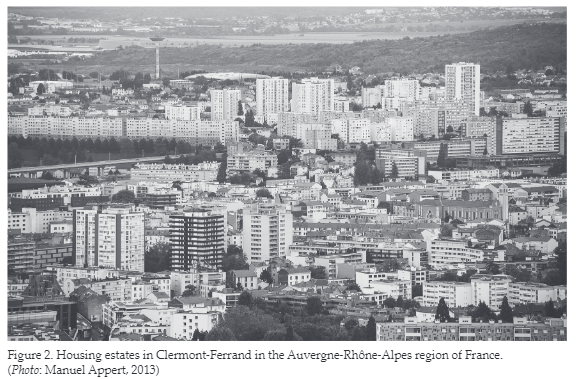
The epitome of the architectural modern-ization of European cities in the post-war period, high-rise urbanism was initially char-acterized by the construction of large-scale residential developments made of slab and point blocks and sometimes large-scale con-crete platforms which, following Corbusian principles of modernist urban planning, sep-arated high-rises from traffic infrastructure and historic centres (Esher, 1981; Monclus and Dies Medina, 2016). High-rise urbanism was then an essential feature of the expansion of Fordist developmentalist states in western and Eastern European countries (swenarton et al., 2014; Hatherley, 2016). as Jacobs et al.(2012, p. 132) argue, it was ‘the materialisation of a specific modernising vision for cities and city life, one that joined the progressive ethos of state-led welfarism with a modernist ar-chitectural aesthetics’. During this high-risepeak, architectural and urbanism referencesfollowed similar developments acrossEurope with a large number of slab-blocks built on the outskirts of towns and cities, re-flecting the importance of decision processes centralized by the post-war central state. But, as Turkington et al. note in their 2004 study, European cities then diverged with regards to the construction and dissemination of a high-rise urbanism. In western Europe most of the high-rise construction stopped in the 1980s, but the building of high-rise residential estates continued in Eastern European cities into the 1990s (Turkington et al., 2004, p. 266) (figure 3).
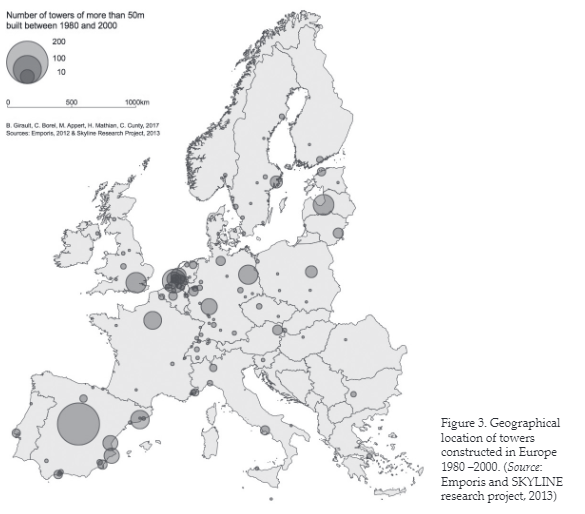
During the 1970s and 1980s, European high-rise urbanism became the locus for long-standing processes of demonization and stigmatization following a series of isolated incidents such as the collapse of Ronan point Tower in London (1968), the demise of large-scale social housing projects in France (Kad-dour, 2016), the broader restructuring and privatization of public housing in most Eu-ropean countries (power, 1993; sailer-Fliege, 1999) and the controversies that followed the construction of stand-alone high-rise office towers such as Tour Montparnasse in paris or Centre point in London. Having been one of the fields of experimentation for vertical ur-banism, several European cities experienceda reaction against high-rises that correlatedwith the institutionalization of forms ofheritage protection. after modernism, came the valuing of more pastiche or postmodern forms of urbanism, putting the accent more on morphological continuity and the conser-vation of historic urban centres (appleyard, 1979; Delafons, 1998; Glauser, 2016). Many heritage lobbies, which became major play-ers in the contemporary regulation of urban planning in European cities, were created in reaction to reconstruction and modernization projects (Backouche, 2016). The contemporary wave of verticalization must be understood in reference to these multiple legacies of a disputed vertical urban past, and is a distinc-tive feature of the European high-rise context(figure 4).
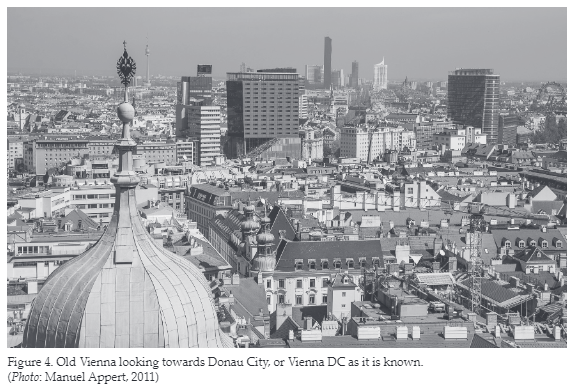
Nevertheless, the protected skylines of European cities have been troubled in the last 15 years by new waves of tall build-ings and high-rise residential structures, a tendency which has not been limited to the main global urban centres and is affecting a diverse range of cities (Drozdz and appert, 2012). The number of towers currently under construction exceeds the post-war boom pe-riod and high-rises are once again finding a certain legitimacy in European cities (appert, 2016). This contemporary high-rise urbanism in Europe comes in different sizes and forms. while the resurgence of skyscrapers has been a major phenomenon, including those that had put in place the most drastic anti-tower legislation after the modernist period, the process of verticalization in Europe has been far from linear, has not necessarily happened in the same type of locations, and has not pro-duced an urban form with unified properties.
The comparison of the spatial distribution of towers built in the 1980s and during the post-2000 period reflects the diversity of loca-tions for new towers in the last 10 years. Until the 2000s, the verticalization of European cen-tres corresponded to a piecemeal moderniza-tion of business districts that accompanied the rise of global finance in property markets for office buildings (Lizieri, 2009). The construc-tion of new towers in Europe was then main-ly limited to international financial centres where the progressive elevation of heights contrasted with the sprawl of low- and me-dium-density suburbs around them and the diffusion of blanket regulations over historic centres (for instance, La Défense vs Central paris, or Donau City vs Vienna inside the Ring). During the 2000s, on the other hand, tower projects proliferated in European cit-ies, a process that can be understood as very much part of globalization and the financial-ization of real estate, even in cities that seem to be more marginal to these hyper-specula-tive economic markets (figure 5).
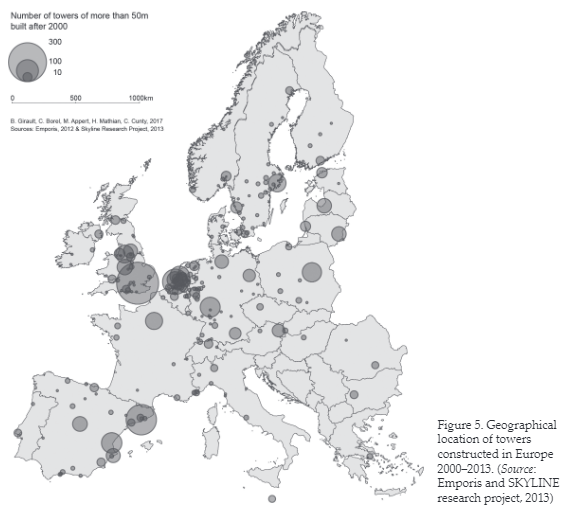
In cities such as Madrid, Milan, Turin or paris, a few monumental towers have come to break the silhouette of the cityscape, but with-out reaching the extent of London, where, as of 1 January 2015, more than 400 tower proj-ects were proposed, approved or under con-struction. The Chamartín district of Madrid has become home to the eponymous Cuatro Torres, while Barcelona has gone vertical with urban renewal operations at Fira de Barcelona or Diagonal Mar. south of the alps, Milan has been gracing the covers of specialist journals following the construction of the Bosco Ver-ticale, while Turin, not without opposition, allowed Renzo piano to build Torre san paolo. Further north, the Turning Torso has redefined the image of the city of Malmö in sweden.
However, the post-2000 boom in vertical construction in Europe is not necessarily ex-emplified in super-tall futuristic structures like those in Middle Eastern and asian cities, but in supposedly compact energy-efficient residential urban blocks according to new high-rise urbanism principles. woven into the existing city fabric, these projects are often framed from the ground up, as initia-tives to reinvigorate local deprived or de-in-dustrialized neighbourhoods and to create urban amenities around transport nodes, embodying new sets of discourses and prac-tices among built environment professionals and planning authorities (appert, 2012). The particular historical context in urban Europe also gives much strength to heritage and con-servation groups and lobbies who strongly shape the height outlines of the European urban landscape, prompting the need to ex-amine closely the conditions of the emergence of a (renewed) European urban vernacular of contemporary high-rise urbanism (figure 6).
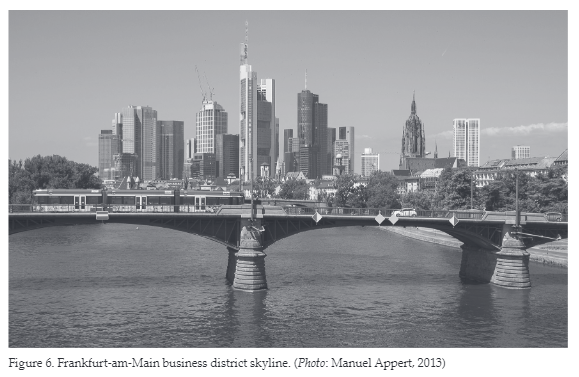
Considering this diversity of contempo-rary forms of high-rise urbanism, this issue ofBuilt Environment explores a range of practicesand manifestations across Europe accord-ing to three main perspectives: (i) politicaleconomy; (ii) heritage and planning; and (iii) symbolic landscapes. The first of these con-cerns contemporary high-rise construction, demolition and maintenance, and is a core component of the papers by Craggs, Lenne, Huré et al., and Charney and Rosen. Follow-ing seminal works on the role of financial intermediaries and instruments in the verti-calization of North-american cities (weber, 2015), these four papers explore how Europe-an cities are located on the emerging global map of investment flows and trace back the genealogy of entrepreneurial forms of verti-calization which started in the 1970s. They offer insights to evolutions within internationalfinancial systems to show how the creation of new investment vehicles like REITs (Real Es-tate Investment Trusts) are driving (some of) the verticalization of European cities.
The physics of tall buildings and their ar-chitectural and engineering qualities have been the locus of a renewed interest (al-Kod-many, 2017); however the role of consultants and experts who guide investment and influ-ence decision-makers, prioritize places and participate in the construction of what could be identified as a European tower market remains underexplored. In the fierce com-petition between European cities to attract investment, we seem to be witnessing a new common urban rationale in which the pres-ence of high-tech towers would allow urban centres to distinguish themselves and signal their economic dynamism (Grubbauer, 2014). Built and run by a variety of intermediaries, this intra-European market for entrepreneur-ial verticalization is structured by such sig-nals of local economic success. Like any mar-ket, it has echo chambers such as the MIpIM (Le marché international des professionnels de l’immobilier – the International Real Estate Pro-fessionals Trade Show, hosted in Cannes every March), where professionals of this small economic world are now presented with new tower projects, ‘unveiled’ with fanfare to at-tract investment.
The paper by Loïse Lenne explores the archaeology of contemporary commercial high-rise urbanism in the City of London by focusing on the history of one particular edifice, the Lloyd’s Building, constructed in 1986 and designed by Richard Rogers and partners. archives and interviews with plan-ners and architects, including Richard Rogers himself, provide the material for a detailed analysis of how the construction of this par-ticular building was a turning point for the theory and practice of high-rise urbanism and tall buildings in the City. Having designed several of its architectural landmarks such as the Lloyd’s Registers, 88 wood street or the recent Leadenhall Building (completed in2014), Rogers and his team have had a consid-erable influence on the physical fabric of the City. Lenne’s paper examines how their first intervention in the square Mile, the Lloyd’s Building, set the principles that still underpin tall buildings projects in the City. Not par-ticularly tall (95 metres high when Tower 42 completed in 1980 reached 183 metres), this building was nonetheless the only building of this size to be allowed at a time when high construction had been banned in the City. The debate around the building introduced new arguments where architectural quality was used as grounds to relax heritage regulations. assessing the architectural qualities of the building, Lenne shows that it also represent-ed a major change in the imaginary of the de-velopment of the City, shifting from compre-hensive public-led urban redevelopments to a piecemeal approach responding to the market needs.
If the architectural principles supporting the current wave of tall buildings in the Cityof London can be traced back to the 1980s, DavidCraggs’s paper explores how the recent surge in skyscrapers has been backed by a partic-ular political economy which appears to beincreasingly entangled with the dynamics of international property markets. Departing from the debates about the contested poli-tics of tall buildings and the management of London’s skyline, this paper assesses the financial forces driving the contemporary development of skyscrapers in London and questions the apparent consensus among London’s planning industry to supportthis highly speculative stage of high-rise ur-banism. As the 2008–2010 crisis offered an opportunity for new institutional investors to acquire a share in the prime market of central London, it reinforced the position of London as a magnet for an ever-expanding volume of capital searching for a return through the exploitation of the built environment. But the paper also exposes the fragility of the under-pinnings of this vertical expansion, rooted in a ‘dependency on rising asset-prices, loose monetary policy and the wealth preserving instincts of the global financial elite’. Reflect-ing on the patterns of capital accumulation through the built environment and its polit-ical regulation (or lack of) through planning, the paper also illustrates how the current growth of skyscrapers signals a profound shift in the ideology and spatial imaginaries that supported high-rise urbanism in Europe, particularly during the post-war period. while the commercial skyscrapers used to signal the peak of a building cycle in highly regulated markets, and the mass production of housing was absorbing much of the re-sources (capital and labour), the current pro-liferation of isolated monumental structures serves the purpose of producing a continuous stream of rental revenues for a constellation of investors in a crisis-prone environment. This shift is also manifest in the very physicality of the built environment and the weakening of comprehensive, public-led large-scale urban development projects, progressively replaced by splintered forms of planning (Graham and Marvin, 2001). Interestingly enough, the scale of these rent machines has expanded (santia-go Calavatra’s project for the Greenwich pen-insula has reached the stratospheric price of £1 billion) to the point where whole areas of European cities are again the subject of com-prehensive private-led redevelopment, and developers are reinventing a wholesale high-rise urbanism targeted at securing different streams of rental revenues.
If understanding how the global restruc-turing of capital flows and the actions of mar-ket intermediaries may help in explaining some of the pressures towards verticalization in European cities, this perspective needs to be supplemented by an exploration of how local political elites and planners also inter-vene in the production of towers. The paper by Maxime Huré, Christian Montès and Manuel appert and that by Gillad Rosen and Igal Charney demonstrate that the somehow counter-intuitive geography of contemporary verticalization in Europe, far from reflecting only the geography and spatial conventions of real-estate experts, finds its root in intense political and regulatory activity that needs to be unpacked. Using, respectively, the cases of Lyon and Jerusalem, they show that the re-emergence of towers in urban centres does not always flag the insertion of a city into highly financialized real-estate markets, although it hints at entrepreneurial turning points in their urban policies (Charney and Rosen, 2016; Kaika, 2010). The evolution of the professional culture in architectural firms and planning authorities to adjust to vertical shifts and/or encourage them, and their adaptation to the demands and needs of international consultants is also part of this political mobili-zation. Using numerous planning documents, media coverage and interviews with public figures, NGOs and real-estate experts, their papers illustrate how a pro-growth agenda has dominated the development of tall build-ings in both cities and toned down the polem-ics and controversies that characterized the previous rounds of high-rise projects. Both papers reflect on the politics of contemporary high-rise urbanism in each city and explore the response of the public to these important changes. In Jerusalem, where heritage plan-ning and height limitations were introduced by British planners at the turn of the twenti-eth century, high-rises have triggered several waves of opposition coming from both NGOs and heritage experts. The impossibility to discuss in a meaningful manner the intro-duction of new tall buildings in the city and the absence of arenas where this debate could take place finally lead the authors to highlight the post-political or what we could even call non-political qualities of the debate. In Lyon, the introduction of a special policy guidance on tall buildings helped create a consensus among planning and heritage experts, politi-cians and residents’ associations who agreed on containing the construction of tall build-ings near the main train station. However, the authors highlight that the very need for new tall buildings and skyscrapers in an economic context where the demands still seem limited was never openly discussed in public arenas.
The second core thematic shaping this issue’s engagement with the dynamics of contemporary high-rise urbanism in Europe concerns planning and heritage, and is a cen-tral aspect of the papers written by Greco and Nijhuis and Van der Hoeven. Looking at the cases of Lyon and Turin, Elena Greco’s paper retraces how planning for tall buildings hasevolved from the 1960s to the new millennium.She shows how the first major wave oftall buildings in Lyon and Turin during the 1960s and 1970s materialized there the advent of the vertical modern city, yet despite being radically different from what was previous-ly built, high-rise clusters were the result of strong planning regulations and codes that paradoxically related more to the urban fabric of these historic cities than the loose strategic guidelines developed more recently. since the 1990s, in addressing processes of de-indus-trialization and looking for new economic resources, urban planning has become more negotiated, opening up opportunities for pri-vate sector actors to initiate high-rise devel-opments in targeted areas or projets urbains. accompanying forms of urban design have consequently changed, being reduced in scale to specific locations where tall buildings are expected and in the process losing sight of city-wide elements of design. The regulation of the European historic environment through the processes of conservation – institution-alized following effective or proposed radi-cal transformations of cities – has come into direct collision with the latest tall building projects proposed as a means of leveraging economic development, fiscal revenues and rebranding cities. Steffen Nijhuis and Frank-lin van der Hoeven illustrate this through the case of The Hague considering how high-rises can epitomize the predominance of economic development goals over urban planning principles, including the protection of urban heritage. Both these papers acknow-ledge the lack of consultation and assessment of the landscape impacts of tall buildings in Lyon, Turin and Dutch cities, despite exist-ing tools and methodologies. Nonetheless, as an important rejoinder, Nijhuis and Van der Hoeven demonstrate how visibility analysis can overcome the subjectivity of perceived urban transformations often instrumental-ized in debates surrounding high-rise con-struction. Landscape analysis through GIs-based modelling can often help planners and politicians map the visibility of tall buildings so as to better confine or design tall buildings in relation to the existing urban fabric.
The last four papers of the issue, working across social policy, film studies and urban geography, explore how the changing sym-bolic landscapes and cultural representations of high-rise urbanism in contemporary Eu-rope need to be mapped directly onto new class relations and trajectories of neoliberal urbanism. all four of these papers, develop-ing analysis of a range of material including audio-visual texts, planning documents and oral histories, chart in particular how the high-rise residential block has lost much of its post-war egalitarian and modernist social cre-dentials. These have been largely superseded by a strong emphasis on upmarket lifestyles and investment priorities, and in the case of the UK and France have become part of a widespread and systematic programme of so-cial housing demolition. In investigating the key intersections between political and cul-tural dimensions of high-rise life, these four papers not only provide sharp critical per-spectives on the unequal vertical geographies emerging in Europe today, but emphasize how high-rise residential landscapes need to be understood as framed, sustained and ne-gotiated through particular representational strategies and urban visions.
The paper by Essi Viitanen uses an in-depth analysis of four feature-length films from the last 5 years set in and around Helsin-ki to examine the relationship between high-rise urbanism and the changing social worlds of the Finnish suburbs, known as lähiö, asso-ciated from the 1950s with state-built mod-ernist housing blocks. Viitanen assesses the way that cinematic space depicts and engages with new forms of everyday lived experience associated with the high-rise landscapes of these marginalized suburbs and the asso-ciated framing and play around themes of constraint, alienation and dysfunction. also providing a focus on the way high-rise urban-ism in Northern Europe has been mediated through film, Pei-Sze Chow’s paper explores screen representations of scandinavia’s tallest building, the Turning Torso (2005) in Malmö, designed by the spanish architect santiago Calatrava, and regarded as the world’s first ‘twisted’ skyscraper. Chow develops a close analysis, rooted in an emphasis on film as a form of social practice, of the documentary film Sossen,Arkitekten och det Skruvade Huset (2005) and the television crime drama series, Bron/Broen (2011–), that has found wide-spread international exposure on the wave ofa ‘Nordic Noir’ trend. Chow uses these filmictexts to detail how this iconic example of high-rise European residential architecture is indicative of sharp tensions between welfare state ideology and neoliberal trajectories of post-industrial urbanism, in this case accom-panying the development of the Øresund region straddling southern sweden and Co-penhagen.
This emphasis on the unravelling of wel-farist social policies through dramatically altered high-rise landscapes continues in the final two papers of this issue by Vincent Ves-chambre and Vikki McCall and Gerry Mooney. These take us to France, the European coun-try with the greatest concentration of tower and slab blocks, and Glasgow, the European city with perhaps one of the highest number of high-rise social housing blocks. Both detail a similar story around the changing fortunes for tower-blocks over the last half-century. post-war idealism around their role in urban policy, part of what Veschambre calls an agen-da of ‘monumentalization’ in French social housing, quickly mutated to sustained disin-vestment from the 1970s. Critically, this was accompanied by the architectural discrediting of high-rise blocks and the stark territorial stigmatization of areas where they were con-centrated. The resulting negative narratives and discourses of ‘failure’ surrounding the people and places involved have been used by states and municipalities to justify and nat-uralize their demolition as the only response; a process Veschambre describes as ‘deverti-calization’. The symbolic logic of this agenda of tower demolition perhaps reached an ex-treme apogee in the UK with plans, as McCall and Mooney document, to broadcast globally the blow-down of the Red Road towers in Glasgow as part of the opening ceremony of the 2014 Commonwealth Games.
although these four papers portray a downbeat assessment of the socially pro-gressive scope for high-rise living in contem-porary Europe, exemplified by the horrific tragedy of the Grenfell Tower in London in June 2017, they also offer crucial ways of re-viewing the place for vertical life in Europe-an cities. whether it is a focus on everyday multi-ethnic practices in suburban Helsinki, isolated examples of tower rehabilitation inthe auvergne-Rhône-alpes region, documen-tary films that highlight the contradictionsinherent to iconic vertical development, or the renewed radicalization of the UK’shousing crisis, these papers open up importantnew means of critically deconstructing – and in the process reconstructing – the social and political possibilities for the high-rise in the contemporary European imagination.
REFERENCES
- Al-Kodmany, K. (2017) Understanding Tall Buildings: A Theory of Placemaking. New York: Routledge.
- Appert, M. (2012) skyline policy: the shard and London’s high-rise debate. Metropoli-tics. available at: http://www.metropoli-tiques.eu/skyline-policy-the-shard-and.html.
- Appert, M. (2016) The resurgence of towers in European cities. Metropolitics. available at: http://www.metropolitiques.eu/The-Re-surgence-of-Towers-in.html.
- Appert, M., Huré, M. and Languillon, R. (2017) Gouverner la ville d’exception et ville ordinaire. Géocar-refour, 91(2), pp. 3–12.
- Appleyard, D. (1979) The Conservation of Euro-pean Cities. Cambridge, Ma: MIT press.
- Backouche, I. (2016) Paris transformé: le Marais, 1900–1980: de l’îlot insalubre au secteur sau-vegardé. paris: Créaphis.
- Beeckmans, L. (2014) The adventures of the French architect Michel Ecochard in post-independence Dakar: a transnation-al development expert drifting between commitment and expediency. The Journal of Architecture, 19(6), pp. 849–871.
- Charney, I. and Rosen, G. (2014) splintering skylines in a fractured city: high-rise geog-raphies in Jerusalem. Environment and Plan-ning D, 32(6), pp. 1088–1101.
- Cohen, J.-L. (1995) Scenes of the World to Come: European Architecture and the American Chal-lenge, 1893–1960. parisand Montréal: Flam-marion; Canadian Centre for architecture.
- Delafons, J. (1998) Politics and Preservation: A Policy History of the Built Heritage, 1882–1996. London: E & FN spon.
- Drozdz, M. and appert, M. (2012) Re-Un-derstanding the CBD: a Landscape per-spective. LaTTsworking paper. available at: https://halshs.archives-ouvertes.fr/halshs-00710644.
- Esher, L. (1981) A Broken Wave: The Re-building of England, 1940–1980. London: allen Lane.
- Fredenucci, J.-C. (2003) L’entregent colonial des ingénieurs des ponts et Chaussées dans l’urbanisme des années 1950–1970. Vingtième Siècle. Revue d’histoire, 79(3), pp. 79–91.
- Gartman, D. (2000) why modern architecture emerged in Europe, not america: the new class and the aesthetics of technocracy. The-ory, Culture & Society, 17(5), pp. 75–96.
- Glauser, a. (2016) Contested cityscapes: pol-itics of vertical construction in paris and Vienna, in Lopez, J.T. and Hutchison, R. (eds.) Public Spaces: Times of Crisis anville verticale: entre ange. Bingley: Emerald Group publish-ing, pp. 221–254.
- Graham, s. and Marvin, s. (2001) Splintering Urbanism: Networked Infrastructures, Tech-nological Mobilites and the Urban Condition. London: Routledge.
- Graham, S. and Hewitt, L. (2013) Getting off the ground on the politics of urban verti-cality. Progress in Human Geography, 37(1), pp. 72–92.
- Grubbauer, M. (2014) Economic imaginaries and urban politics: the office tower as so-cially classifying device. International Jour-nal of Urban and Regional Research, 38(1), pp. 336–59.
- Harris, a. (2015) Vertical urbanisms opening up geographies of the three-dimensional city. progress in Human Geography,39(5), pp. 601–620.
- Hatherley, O. (2016) Landscapes of Communism: A History Through Buildings. London: pen-guin Books.
- Jacobs, J.M., Cairns, s. and strebel, I. (2012) Materialising vision: performing a high-rise view, in Rose, G. and Tolia-Kelly, D.p. (eds.) Visuality/Materiality: Images, Objects and Practices. London: Routledge, pp. 133–152.
- Kaddour, R. (2016) The complex repre-sentations of working-class residential towers. The rise and fall of the plein Ciel tower in three acts. Metropolitics. avail-able at: http://www.metropolitiques.eu/The-complex-representations-of.htm-l?lang=fr.
- Kaika, M. (2010) architecture and crisis: re-in-venting the icon, re-imag(in)ing London and rebranding the City. Transactions of the Institute of British Geographers, 35(4), pp. 453–474.
- Kasmi, a. (2017) The plan as a colonization project: the medina of Tlemcen under French rule, 1842–1920. Planning Perspec-tives. https://doi.org/10.1080/02665433.2017.1361335.
- Lizieri C. (2009) Towers of Capital: Offices Markets and International Financial Services. Chichester: wiley-Blackwell.
- Monclus, J. and Dies Medina, C. (2016) Mod-ernist housing estates in European cities of the western and Eastern blocs. Planning Perspectives, 31(4), pp. 533–562.
- Picard, a. (1994) architecture et urbanisme en algérie. D’une rive à l’autre (1830–1962). Revue du monde musulman et de la Méditer-ranée, 73(1), pp. 121–36.
- Power, a. (1993) Hovels to High Rise: State Housing in Europe Since 1850. London: Routledge.
- Sailer-Fliege, U. (1999) Characteristics of post-socialist urban transformation in East Central Europe. GeoJournal,49(1), pp. 7–16.
- Stanek, Ł. (2012) Introduction: the ‘Second world’s’ architecture and planning in the ‘Third world’. The Journal of Architecture, 17, pp. 299–307.
- Swenarton, M., avermaete, T. and Van den Heuvel, D. (2014) Architecture and the Wel-fare State. London: Routledge.
- Taillandier, I., Namias, O. and pousse, J.-F. (ed.) (2009) L’invention de la tour européenne. The invention of the European tower. paris: pavillon de l’arsenal; picard.
- Turkington, R., Van Kempen, R. andwassenberg,F. (2004) High-Rise Housing in Europe: Cur-rent Trends and Future Prospects. Delft: Delft University press.
- Verdeil, E. (2012) Michel Ecochard in Lebanon and syria (1956–1968). The spread of mod-ernism, the building of the independent states and the rise of local professionals of planning. Planning Perspectives, 27(2), pp. 249–66.
- Weber, R. (2015) From Boom to Bubble: How Finance Built the New Chicago. Chicago, IL: University of Chicago press.

